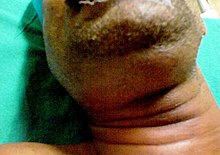| Ludwig's angina | |
|---|---|
| Other names | Angina ludovici |
 | |
| Swelling in the submandibular area in a person with Ludwig's angina. | |
| Symptoms | Fever, pain, raised tongue, trouble swallowing, neck swelling[1] |
| Complications | Airway compromise[1] |
| Usual onset | Rapid[1] |
| Risk factors | Dental infection, upper respiratory infection, mouth piercing, poor immune function, diabetes, alcoholism[2][1] |
| Diagnostic method | Based on symptoms and examination, CT scan[1] |
| Treatment | Antibiotics, corticosteroids, endotracheal intubation, tracheostomy, surgery[1][2] |
| Frequency | Rare[3] |
Ludwig's angina is a type of severe cellulitis involving the floor of the mouth.[4] The condition is of rapid onset and worsens quickly.[4] Symptoms generally include fever, a raised tongue, neck swelling, pain, and trouble swallowing.[1] The floor of the mouth is often hard and there may be a decreased ability to open the mouth.[2] As the condition worsens airway compromise may occur.[1] Other complications may include mediastinitis and jugular vein thrombosis.[5]
The majority of cases (70%) follow a dental infection, particularly from the molars, though it may also occur following an upper respiratory infection.[1][2] Other risk factors include piercing inside the mouth, poor immune function, diabetes, and alcoholism.[2] It specifically involves the submandibular, submental, and sublingual spaces and generally many types of bacteria are involved.[1][2] Diagnosis is generally made based on symptoms, though may be supported by CT scan.[1]
Prevention is by appropriate dental care including management of dental infections.[6] Initial treatment is generally with broad-spectrum antibiotics and corticosteroids.[1] In more advanced cases endotracheal intubation or tracheostomy may be required.[1] Other measures may include nebulized epinephrine and surgery.[2] The risk of death is about 8%; though is as high as 50% without treatment.[2]
Ludwig's angina is rare.[3] Both sexes are affected equally frequently.[7] It is named after a German physician, Wilhelm Frederick von Ludwig, who clearly described the condition in 1836.[8] However; earlier descriptions date back to the time of Hippocrates around 400 BC.[5] With the advent of antibiotics in 1940s, the rates of disease and risk of death was reduced.[5]
References edit
- ^ a b c d e f g h i j k l m Gottlieb, M; Long, B; Koyfman, A (May 2018). "Clinical Mimics: An Emergency Medicine-Focused Review of Streptococcal Pharyngitis Mimics". The Journal of Emergency Medicine. 54 (5): 619–629. doi:10.1016/j.jemermed.2018.01.031. PMID 29523424.
- ^ a b c d e f g h Bridwell, Rachel; Gottlieb, Michael; Koyfman, Alex; Long, Brit (March 2021). "Diagnosis and management of Ludwig's angina: An evidence-based review". The American Journal of Emergency Medicine. 41: 1–5. doi:10.1016/j.ajem.2020.12.030.
- ^ a b Fong, Yuman; Kauffmann, Rondi Marie; Marcinkowski, Emily; Singh, Gagandeep; Schoellhammer, Hans F. (17 November 2016). Surgical Emergencies in the Cancer Patient. Springer. p. 274. ISBN 978-3-319-44025-5. Archived from the original on 1 October 2022. Retrieved 1 October 2022.
- ^ a b Candamourty R, Venkatachalam S, Babu MR, Kumar GS (July 2012). "Ludwig's Angina - An emergency: A case report with literature review". Journal of Natural Science, Biology, and Medicine. 3 (2): 206–8. doi:10.4103/0976-9668.101932. PMC 3510922. PMID 23225990.
{{cite journal}}: CS1 maint: unflagged free DOI (link) - ^ a b c Fleisher, Lee A. (20 April 2012). Anesthesia and Uncommon Diseases E-Book. Elsevier Health Sciences. p. 24. ISBN 978-1-4557-3755-0. Archived from the original on 1 October 2022. Retrieved 1 October 2022.
- ^ Fehrenbach, Margaret J.; Herring, Susan W. (27 December 2013). Illustrated Anatomy of the Head and Neck - E-Book. Elsevier Health Sciences. p. 278. ISBN 978-0-323-29108-8. Archived from the original on 1 October 2022. Retrieved 1 October 2022.
- ^ An, J; Madeo, J; Singhal, M (January 2022). "Ludwig Angina". PMID 29493976.
{{cite journal}}: Cite journal requires|journal=(help) - ^ Murphy SC (October 1996). "The person behind the eponym: Wilhelm Frederick von Ludwig (1790-1865)". Journal of Oral Pathology & Medicine. 25 (9): 513–5. doi:10.1111/j.1600-0714.1996.tb00307.x. PMID 8959561.